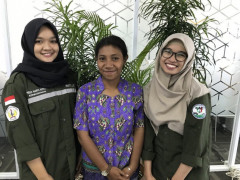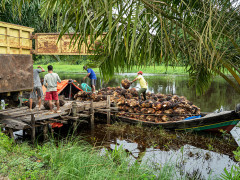Vulnerability to Forest and Land Fires (Karhutla) and The Concessions Within
By AdminJilid 2 Waspada Bencana Asap Karhutla Semasa Pandemi
Retrospect on Wildfire and the Pandemic
At the end of 2019 in Wuhan, China, in only a matter of months, panic struck Indonesia after the commotion of the coronavirus outbreak. Since March 2020, the government has known that there have been people infected with the coronavirus in Indonesia. Immediate attention was focused on warding off the pandemic, including follow-up steps regarding economic affairs. When the dry season arrives, environmentalists worry about forest and land fires (Karhutla). The government is reminded of the risk of a double burden, namely the haze caused by forest and land fires (Karhutla) and the pandemic.
In 2020, the fires were less widespread than in 2019. Based on data from the Directorate of Forest and Land Fire Control, the Ministry of Environment and Forestry, there was a decrease of around 81% in the wildfire area in 2020. The area of forest and land fires (Karhutla) was 1.6 million hectares in 2019. It also showed a wildfire area of 296.000 ha in 2020.
Based on Pantau Gambut, the burned peat area decreased by 97 percent. The detailed data were 769,938 hectares in 2019. This number has reduced to 16,356 hectares in 2020.
The wildfire area is smaller due to the La Nina phenomenon (cold phase) in 2020. This phenomenon causes higher rainfall, even during the dry season. Whereas in 2019, the situation is different because of El Nino (warm phase), which causes a longer dry season and infrequent rainfall. The government claims the reduction in fire intensity is due to collaborative efforts with various parties. In early 2020, President Joko Widodo (Jokowi) presided over a national-level coordination meeting. The meeting agenda discussed the handling of the forest and land fires (Karhutla) threat. After the meeting, the Ministry of Environment and Forestry and the police issued a statement. The content of the announcement is an appeal to all persons in charge of businesses or activities in the natural resources sector in the forestry, agriculture, and plantation sub-sectors. They are obliged to carry out efforts to prevent and control forest and land fires.
However, all efforts to anticipate catastrophic fires were suddenly disbanded due to the pandemic in March 2020. Efforts to concentrate budget allocations and human resources were diverted to handling Covid-19. The Ministry of Environment and Forestry acknowledged refocusing the fire control budget for handling Covid-19. However, they argue that control activities are declining. They reasoned that the activities continued with funding assistance, not from the State Revenue and Expenditure Budget.
The Minister of Environment and Forestry, Siti Nurbaya, explained that handling fires remain a priority in the midst of a pandemic. Supervision is still performed by forest and land fires (Karhutla) task force teams and supervision in areas prone to wildfires. Siti Nurbaya has also written to regional heads in early March 2020. She asked all parties, including the private sector and regional stakeholders, to be aware of fire disasters.
Given the urgency of handling forest and land fires, Jokowi again held a limited meeting on handling wildfires on June 23, 2020. Jokowi emphasized four points, including field monitoring activities, fire prevention, law enforcement, and landscape management.
Forest and Land Fire Threat 2021
In 2021, Jokowi will take further steps to provide directions at the National Coordination Meeting for Forest and Land Fire Control at the State Palace, Monday, February 22 2021. The meeting was like an annual routine statement because nothing was different from the directive like the previous year. Jokowi held the meeting when the fire momentum had already taken place in Riau, Central Kalimantan, Jambi, South Sumatra, and West Kalimantan earlier that year.
Based on data released by Sipongi – the forest and land fires (Karhutla) monitoring system – the Ministry of Environment and Forestry, the number of hotspots distributed across all types of land, especially peat and minerals, is indeed low this year. This data is compared to the same period from January to July 2020. But we still need to be cautious because the number of hotspots detected has significantly increased in July
The Meteorology, Climatology, and Geophysics Agency reminded all relevant partakers to anticipate forest and land fires until October 2021. Even so, rainfall was still caught in the middle of the dry season.
This year, there have been fewer hot spots compared to 2020. However, the results of Pantau Gambut's analysis found something else specific. The distribution of hotspots on peatlands was wider from January to July 2021 compared to the same period in 2020. The analysis of hotspots referred to the Visible Infrared Imaging Radiometer Suite (VIIRS) sensor which focuses on peat areas (100 percent confidence level).
Peatland fires that are difficult to extinguish will certainly cause immense losses. The increase in the number of hotspots, especially in peat areas, should be a warning. The government must determine applicable and fast responses to prevent fires.
The Challenge of Handling Forest and Land Fires (Karhutla) During The Covid-19 Pandemic
Based upon the results of hotspots area analysis and the history of fires in early 2021, there was an increase as the peak of the dry season entered. The government must be attentive and strengthen forest and land fires (Karhutla) management activities so that haze fails to happen.
Compared to 2020, the potential threat of a double burden this year will be even more severe given the Covid-19 pandemic. The effort should be more than just repetitive actions. However, development is important because the challenges faced are increasing when facing the haze during the pandemic. Advancement is essential to develop solutions because the challenges faced are increasing when dealing with haze during a pandemic.
The government seeks to prevent fires through various collaborative activities. As for the monitoring of hotspots in an integrated and independent manner, namely, the task force conducts outreach regarding forest and land fires residents. Increasing the role of the Fire Care Community (MPA) is very important as a paralegal group of people who are aware of the law.
This activity may still be constrained due to restrictions on citizen interaction activities. This is because the government has appealed to stop the transmission of the Covid-19 variant of the delta which is more dangerous than the coronavirus at the start of the 2020 pandemic. The delta (B.1.617.2) spreads quickly compared to other variants, 55 percent, to be exact, compared to alpha. Studies from health institutions in Scotland state that people infected with the delta variant of the coronavirus have twice the risk of being hospitalized. The risk is increasing for people who are infected with comorbid conditions.
To prevent the negative effects of the delta variants and forest and land fires (Karhutla), the government needs to improve the effectiveness of handling activities, one of which is weather modification technology (WMT). This technology has been used in Riau, where the first phase was completed from March 10 to April 5, 2021. As a result, rainfall has increased by around 34 percent to 64 percent. Additional rainfall at the cloud seeding location is around 194.3 million cubic meters. In the second phase, the percentage increased rainfall by two percent in Riau in July 2021.
The WMT method is more effective if there are still clouds that can potentially turn into rain. This is more effective during the rainy season, transition, and the beginning of the dry season. During this period, weather modification technology was used to wet the peat and fill canals and reservoirs for the firefighting teams on land.
However, current facts have been found that there has been a decrease in rainfall in a number of fire-prone provinces. A number of provinces experienced more excessive fires when compared to 2020. Could WMT be an effective strategy?
Landscape Management Constraints
Restoration is one of the landscape management activities to improve the peat ecosystem. In Indonesia, the state agencies authorized for these activities are the Peat and Mangrove Restoration Agency (BRGM) and the Ministry of Environment and Forestry. Areas observed include community work areas (non-concessions) and areas with permits (concessions).
Every year, each agency reports the success of restoration based on the area (hectares) within a certain period. Restoration of non-concession areas is often described in the form of commentary or field documentation.
However, peat restoration activities in licensed work areas need to be fully transparent. The public needs to learn how far restoration activities have been developed in the area. The results of Pantau Gambut's investigation at 1,222 sample points from 43 concessions in seven provinces found sad results because it was still below 10 percent of companies achieved restoration.
This incomplete recovery activity raises skepticism about the government's commitment to managing the landscape, particularly concerning the protection of peat ecosystems. Landscape management is an effective and efficient prevention activity to prevent forest and land fires (Karhutla).
The Irony Behind The Restoration
In order to provide food during the pandemic, Jokowi launched a Food Estate program which is a National Strategic Project. This large-scale food storage is reminiscent of the failure of the previous regime's government project, namely the Mega Rice Project in 1996 under Soeharto's rule. In 2010, there was also the Merauke Integrated Food and Energy Estate project during the reign of Susilo Bambang Yudhoyono.
The Jokowi regime's Food Estate project has been planned for 2020. Initially, the project targeted Central Kalimantan as a province with peatlands. Furthermore, the ambition of the Food Granary project is also targeting Jambi, North Sumatra, West Kalimantan, and Papua.
The government guarantees that project implementation has gone through various examines to prevent negative impacts on the environment. However, the Food Estate project actually creates a destructive trend, especially in the peat ecosystem-protected area due to drainage activities. Agricultural activities on peatlands are only possible in shallow areas. So, it is essential to pay attention to the use of natural fertilizers, maintaining the wetness of the peat, and choosing the type of rice that can grow in wetlands. Agriculture in peat areas has the potential to cause degradation due to drainage activities. If large-scale farming is forced to continue, it will cause the peat to dry out, making it vulnerable to fire. The results of Pantau Gambut's investigation in the Strategic Environmental Assessment document for Central Kalimantan, Jambi, North Sumatra displays the planned Food Estate area is located in several National Parks, including Sebangau, Berbak, Kerinci, and Gunung Leuser.
The Food Estate plan area is also located on peat land, which has different characteristics from mineral soil. Peatlands are easily damaged if the management is not handled deliberately and adheres to the rules. So, any plans to use peatlands for plantations or agriculture must be measured.
Budget Swelling Due to Smoke Disaster
If the forest and land fires (Karhutla) occurred during the peak of the dry season this year, the costs required to handle them would surely increase. In fact, extinguishing activities on the ground or in the air is not entirely effective in eliminating fires in peat areas.
If there is a wildfire, the government in which province is prone to disasters will be overwhelmed by the two major disasters. The government must realize that the haze and Covid-19 are increasingly burdening the economy and public health. The policies must have actual usefulness, so it doesn't repeat the same failures and lead to problems in peatlands.



